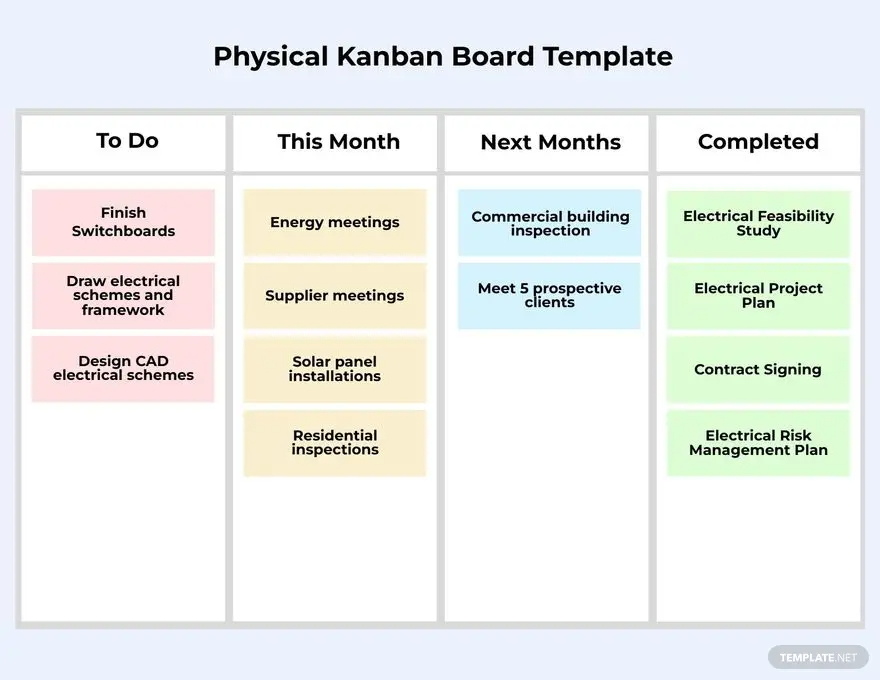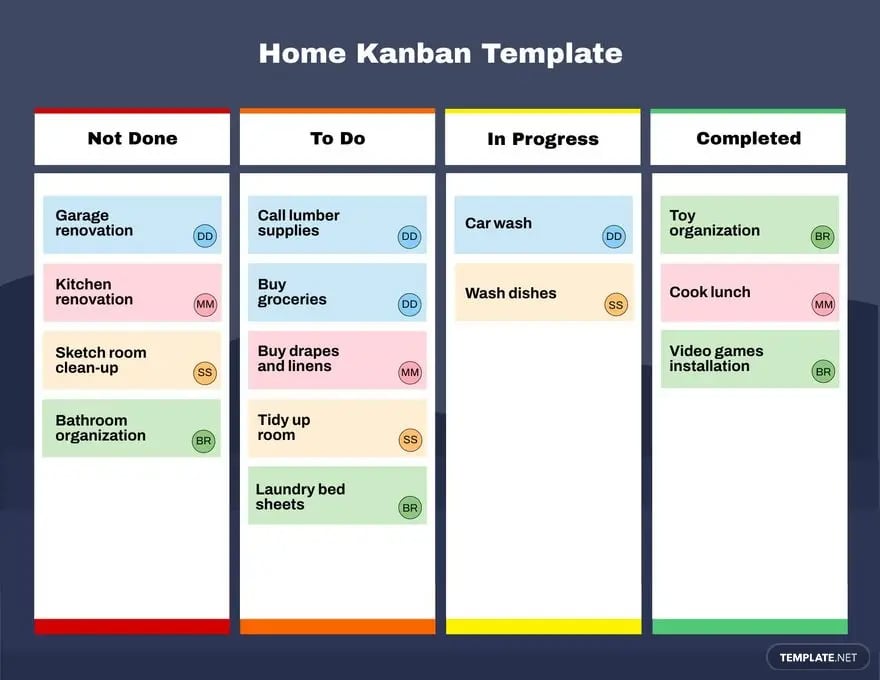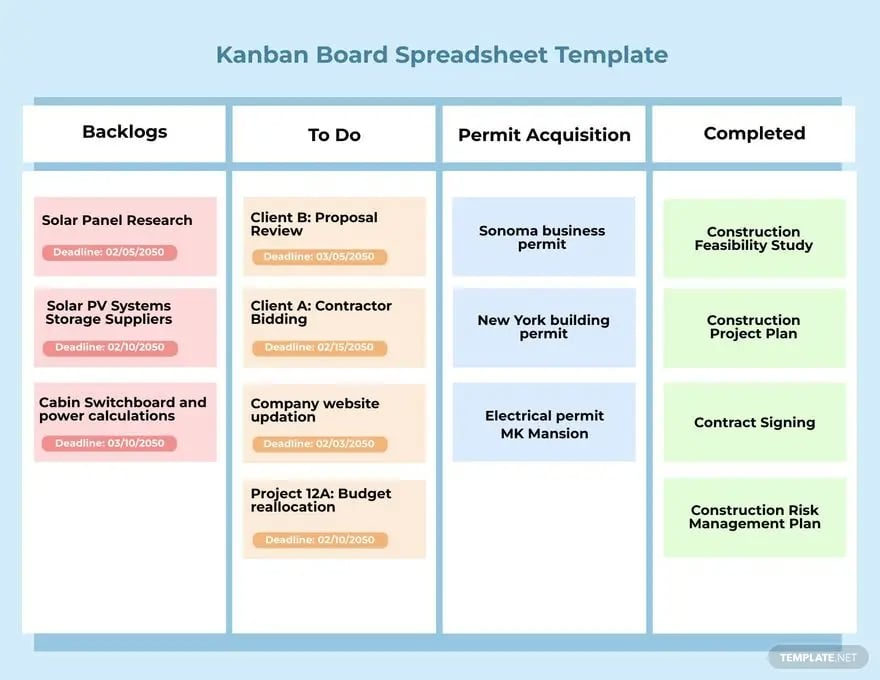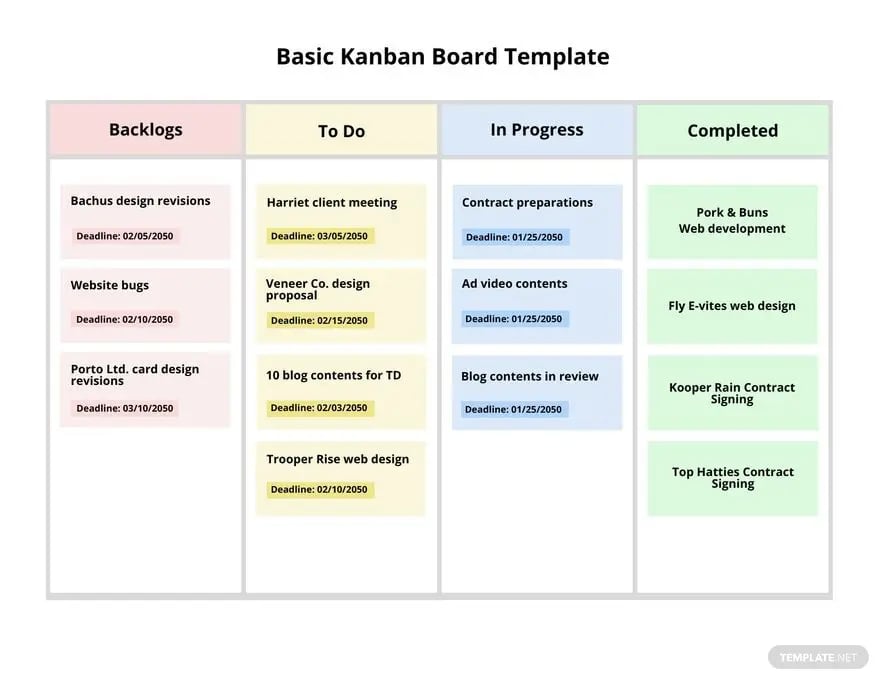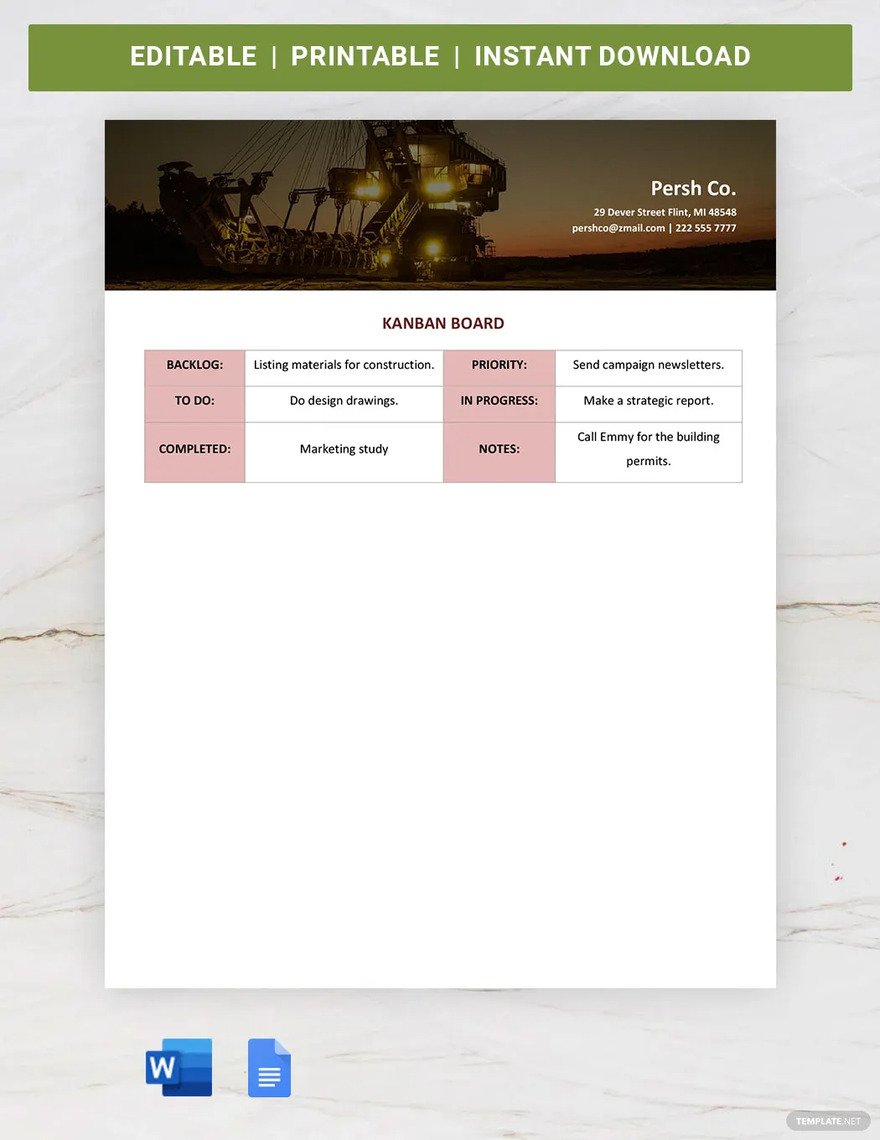Table of Contents
Kanban
Kanban is a popular workflow management technique for defining, maintaining, and enhancing services that deliver knowledge work. It supports continual improvement, efficiency maximization, and task visualization.
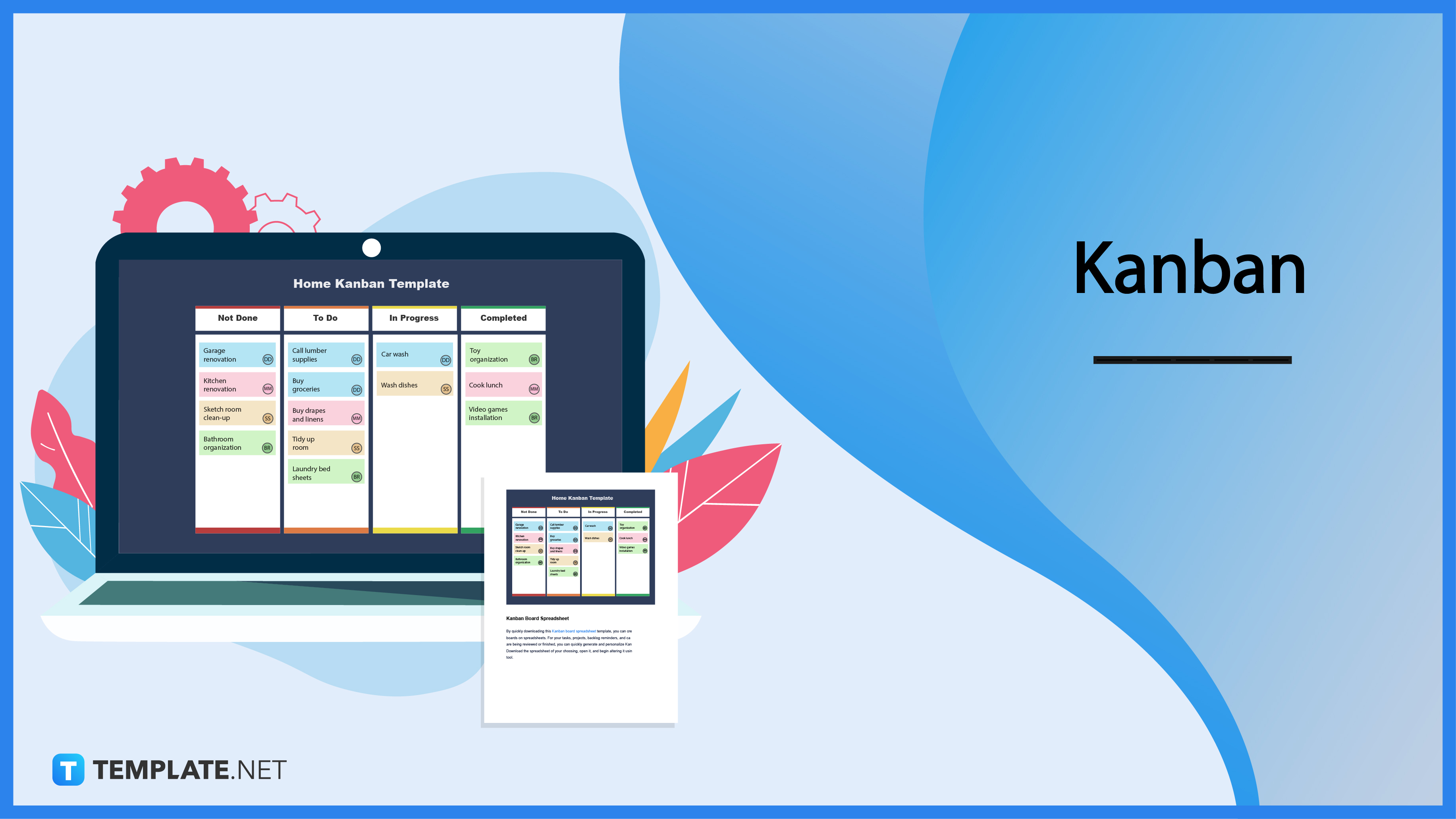
Kanban Definition & Meaning
Since the 1950s, the Japanese phrase “kanban,” which means “visual board” or a “sign,” has been used to refer to a process definition.
Kanban is a visual method for controlling the flow of work through a process.
What Is A Kanban?
Kanban is a methodology that commonly implements Agile and DevOps software development. It advocates for complete work transparency and real-time capacity communication. Team members can always observe the status of each piece of work thanks to the visual representation of work items on a Kanban board.
10 Types of Kanban
Kanban
Use a high-quality Kanban template right away for all of your activities and projects. It is expertly formatted for simple editing and customization to fit your weekly or monthly activities, web development projects, marketing campaigns, construction projects, operational processes, agile tasks, and even more. It’s offered to you in a number of formats for your use.
Physical Kanban Board
The physical Kanban board provides the physical meeting strategy that enhances team engagement and cooperation. This Kanban board has a fantastic, well-organized layout, great content, and is enjoyable to use because it encourages collaboration among the entire team. Users can also easily customize the template to their own design and content in our exclusive Editor tool.
Home Kanban
By downloading and using a home Kanban template, you can easily create a list of your household duties. Using this template, you can quickly assign individuals to particular tasks and chores, remind them of their To-Dos, and thank them for a job well done. It is offered in a variety of file formats for your comfort, simplicity in customization, and software compatibility.
Kanban Board Spreadsheet
By quickly downloading this Kanban board spreadsheet template, you can create Kanban boards on spreadsheets. For your tasks, projects, backlog reminders, and campaigns that are being reviewed or finished, you can quickly generate and personalize Kanban items. Download the spreadsheet of your choosing, open it, and begin altering it using our Editor tool.
Basic Kanban Board
Utilizing and customizing this Kanban board template is simple. Downloading a basic Kanban board template will be very helpful for organizing tasks such as office work, household chores, marketing campaigns, and website development projects. It is well-designed and has been shown to be effective in helping you manage tasks and more.
Kanban Board
Kanban is a visual work management system that offers countless configuration options for work items or processes. The predesigned workspaces in this Kanban board template will help you get started and save time. To handle even the most complex circumstances, you can also integrate sophisticated Kanban capabilities like columns, cross-board workflows, column groups, and rows.
Kanban Uses, Purpose, and Importance
The requirement for increased work visibility and ongoing improvement are the main justifications for implementing the Kanban approach. Its primary objective is to provide teams with a much clearer view of the progress made on each activity. Having said that, it is crucial to understand the uses, objectives, and significance of Kanban.
Flow Visibility is More Visible
Visualizing every piece of an operation is the fundamental principle of Kanban. In this approach, the Kanban board becomes a focal point for information sharing and keeps everyone informed. Because all tasks are visible and never lost, the entire working process is transparent, and the status of each project or task can be quickly updated for every team member.
Accelerated Delivery
Kanban gives project managers a variety of tools to carefully track task distribution and conduct informed analysis. The stages when assignments take the longest to complete and obstacles are simple to spot with a clear view of the work items done for a specific amount of time. Teams are given the tools they need for them to overcome these obstacles and ultimately increase their delivery rate.
Execution Alignment of Business Goals
Kanban procedures provide for the alignment of the company’s strategic goals with the daily work of teams by fostering transparency, promoting feedback, and holding regular review sessions. The aim and execution of a business are in line, which improves an organization’s agility. It enables teams to adjust to shifting priorities and reorganizations brought on by modifications in the market or in the needs of the customers.
Greater Predictability
You can use flow metrics to fully understand your process once you’ve created a Kanban board and begun adding work items to it. Your ability to forecast how much work you can complete in the future will be improved by looking at the amount of time tasks spend in your process (cycle time). Forecasts and judgments based on historical data will be more accurate if you understand the consistency of your delivery rate (throughput).
Improved Client Satisfaction
Work is completed when there is a demand, according to the pull system upon which the Kanban technique is founded. In other words, by focusing only on tasks that are required right now, Kanban guides you to eliminate waste. Furthermore, by incorporating visualization techniques and work-in-progress constraints into the process, you can ensure that the final product meets your customers’ expectations.
What’s In A Kanban? Parts?
Boards
Kanban boards represent the overall workflow organization process in its entirety. The use of the Kanban board allows for the consolidation of pertinent procedures into a single workspace or task board area.
Cards
The smallest, most specific actions required to complete a list are represented by Kanban cards, which are lists themselves. These cards represent the particular items that must be dealt with in a particular order in order to finish the list.
Lists
The to-do tasks on each board are on Kanban lists. Kanban lists can flow from one task to the next; frequently, one job will end and the next task will begin with the next action item once the previous list item has been completed.
How to Design a Kanban?
1. Select the proper Kanban Size.
2. Identify the objective of your Kanban template.
3. Choose a Kanban Template that suits your needs.
4. Draw the diagrams and charts.
5. Input the significant content or infographics based on your needs.
6. Include extra images, vectors, illustrations, logos, clipart, or backgrounds, if necessary.
7. Save or download the personalized Kanban template.
Kanban vs. Scrum
Kanban is all about putting your work into perspective, minimizing work in progress, and increasing productivity (or flow).
Scrum teams pledge to finish a piece of work that may be shippable during predetermined intervals called sprints.
What’s the Difference Between a Kanban, Gantt Chart, and Task Board?
Kanban allows for incremental improvements to the current process as a non-disruptive adaptive change management solution.
A Gantt chart, which is frequently used in project management, is one of the most well-liked and practical ways to represent activities (tasks or events) against time.
A task board is utilized by users, teams, and entire companies to enable them to finish work quickly and effectively.
Kanban Sizes
The key tools for inventory and production projects are available in Kanban, which helps streamline the operations. Here are the most popular Kanban sizes in use, which must be followed while making them in order for them to fulfill their intended purpose.
- Kanban Board Template Size (US Letter, Legal, A4)
- Kanban Card Size (Letter, A4, A7)
Kanban Ideas & Examples
Kanban creation is a fairly simple process, but because they have so many uses and varieties, it’s easy to get caught up. When constructing, using Kanban ideas and examples as a guide should be quite beneficial.
- Kanban Visio Ideas and Examples
- Personal Kanban Ideas and Examples
- Kanban Project Ideas and Examples
- Kanban Notion Ideas and Examples
- Kanban Framework Ideas and Examples
- Kanban User Story Ideas and Examples
- Kanban Ideas and Examples
- Kanban Ideas and Examples
- Kanban Ideas and Examples
- Kanban Ideas and Examples
FAQs
Why is Kanban so successful?
In a sense, users find Kanban to be incredibly successful due to its simplicity.
Why is Kanban so adaptable?
Once more, it is because of its simplicity that all different Kanban implementations have been considered relevant.
How can Kanban aid in the distribution of work and the management of resources?
Work can be divided up and distributed to team members using a Kanban, and each one of them controls their own workload based on personal preferences or priorities.
What does “Lean Kanban” mean?
Lean Kanban is specifically made for knowledge workers and the IT industry.
Does Kanban time-boxed?
Indeed, Kanban has time limits and will assist you in changing from a reactive to a proactive state, and to ensure this, it measures lead time, throughput, contact time, flow efficiency, and other pertinent metrics.
Is Kanban scalable?
Yes, Kanban can be scaled at the project, program, portfolio, service, and enterprise levels.
Do I require particular tools for Kanban?
You will need a task board, priority columns, a planning trigger, lead and cycle time diagrams, and other tools to implement Kanban, but you and your team are not required to use any particular software to do Kanban.
Why do people adopt Kanban?
Kanban is well known for being used within teams to reduce overwork and regain control over the work being completed by the team.
What details are displayed on a Kanban board?
Cards, which indicate tasks, and columns, which show tasks at various phases of a project, are the two primary components of a Kanban board.
What does Kanban lane represent?
A Kanban lane in the template represents a stage in your process, from “To Do” to “Doing” to “Done.”






